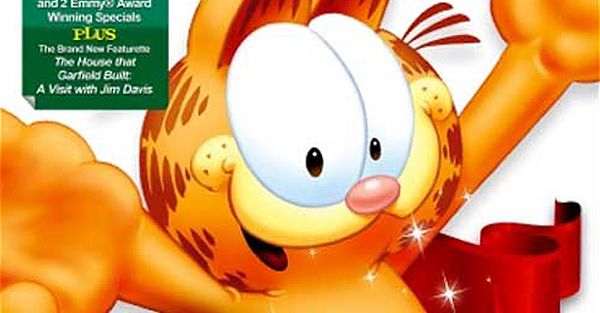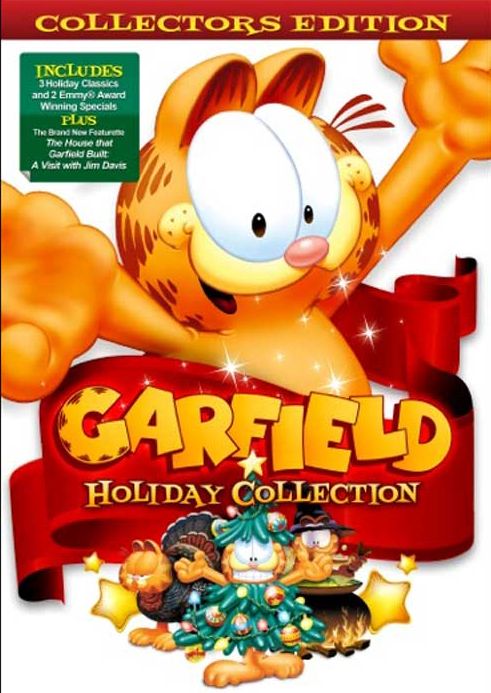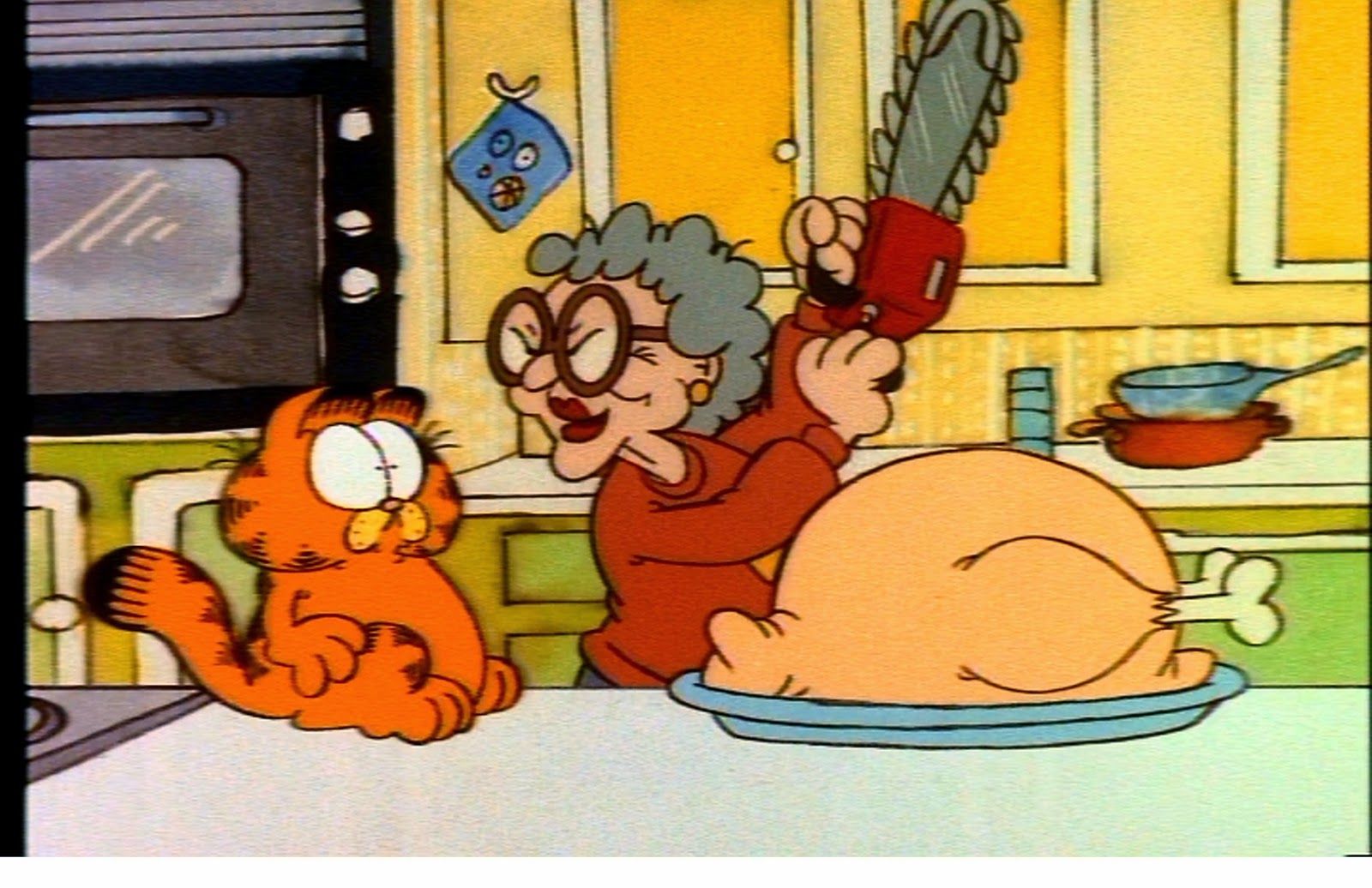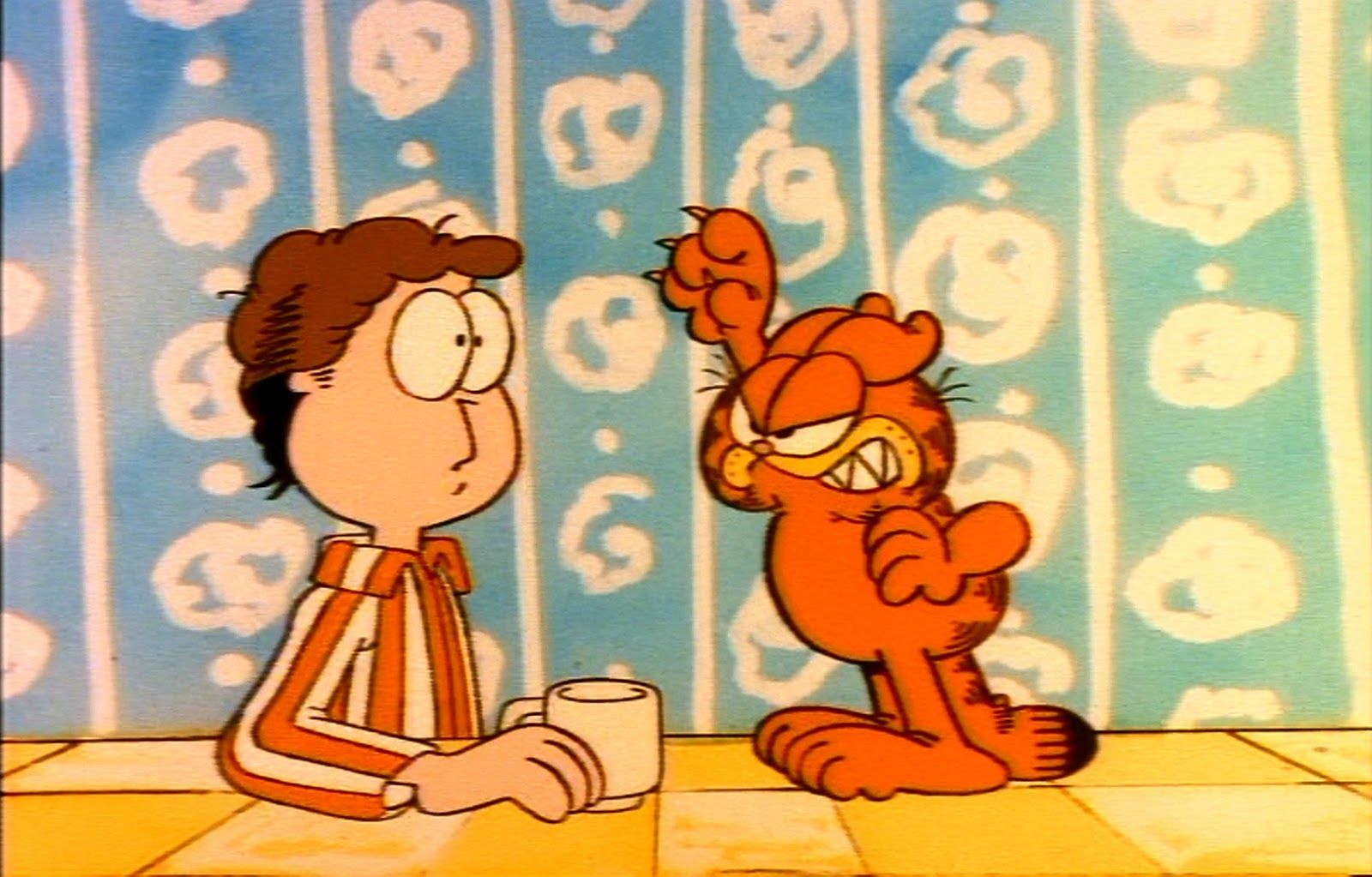Garfield may hate Mondays, but he loves holidays almost as much as he loves lasagna.
The tubby tabby made his debut in 1978 via cartoonist Jim Davis' newspaper strip, and swiftly became a pop cultural touchstone. By 1982, Garfield's popularity had skyrocketed to such heights that CBS cast the cat in a series of animated specials for primetime broadcast, followed by a spate of holiday-themed installments that became eagerly awaited annual staples on par with the legendary Charlie Brown specials. Rebroadcast for years to follow, they feature the inspired choice of writer/producer/voice actor Lorenzo Music's languid tones as the audio embodiment of Garfield's bad attitude.
EXCLUSIVE: Nickel Visits Garfield's Many Incarnations In "9 Lives"
Three of the best-loved holiday specials -- "Garfield's Halloween Adventure," "A Garfield Christmas" and "Garfield's Thanksgiving," as well as standout non-holiday outings "Garfield In Paradise" and "Garfield On the Town" -- have been collected in the new home video release "Garfield Holiday Collection" (available on DVD exclusively at Wallmart Nov. 4, and digital download Nov. 11). In celebration of his fat cat getting his due, Davis reminisced with CBR News about his creation's move to television, how Charles Schulz provided the key to helping the character stand on his own two feet rather than being relegated to all four, Garfield's subsequent movie voice Bill Murray, and being at the epicenter of a culture of cat-centric comedy that, like Garfield himself, still thrives today.
CBR News: It's so nice to see these specials that we all remembers so fondly back in the spotlight again. Tell me what they meant to you, to have the opportunity to bring Garfield to TV, especially knowing the great legacy that something like the "Peanuts" specials had carved out on television.
Jim Davis: Well, it meant a lot. Aside from doing the comic strip, probably, it was the most fun I had, because we worked with actually all the same people who did the "Peanuts" specials -- [Producer] Lee Mendelson, [animator] Bill Melendez -- and we had a ball. I got to actually write the scripts and got to direct the voice tracks and do the storyboards, and so I was 110% invested in all of these stories. For instance, the Christmas special: that's very autobiographical. That was my Christmas on the farm. I did invent Grandma, because I did want to bring in a character who would bring in that element of what Christmas means to a lot of people, being with loved ones and things like that, and that more touching element to it. The Halloween thing, we got to do fun stuff. I'd say one of my favorite specials is "Garfield in Paradise" -- I got to work with Wolfman Jack and rock-n-roll and stuff like that. So there are just a million stories involved with doing those specials through the '90s. And then, too, I was certainly willing to put in the time and effort, because I was probably going to get to do one Christmas special, so for me, I had to give it the very best shot, because it was going to be my only shot to do it. It was great fun.
With the first special we did -- it was "Here Comes Garfield," which is not in the series -- I wanted Garfield to get up and dance for the opening credits. We rotoscoped a dancer, we were going to have to make Garfield run like her, and Garfield just looked terrible. I was at Melendez's, and I was drawing him and the animation, and it just did not look right. And in the next room was Charles Schulz, working on a "Peanuts" special. He asked me how it was going, and I said, "Well, not so well." I showed him my drawings of Garfield and he said, "Well, your problem is, those are cat feet. When I first set Snoopy up, he had little dog feet. So today, when he's down, he's got normal dog feet on all fours, but when he stands up he gets big, human feet. So he's got a base, he's got balance, it looks normal." So he took my drawing and drew big feet on Garfield when he stood up. And it looked great! And it made sense. Plus, he touched my drawing! He was the guy responsible for getting Garfield to stand up for the comic strip, because I'd never been able to do it before. He did this doodle, and it made eminent sense.
Garfield, by that time, was a pop culture sensation. Did you get to have all that creative involvement because of the clout of him being your creation, or was it just sort of a happy thing that happens sometimes, that they invite you in and say, "Run with it. If you want to write this, you can write this."
I wrote the script for fun. I did it on spec. A producer and I knew each other. Sparky [Charles Schulz] had an awful lot of input on his scripts, so he could yea or nay anything in the script. I wrote a script and I took it to the producer, fully expecting him to say, "Well, let me bring some writers in to polish," or anything like that, and he said, "Hey, this is good. It's got nice timing. It's got the humor of the comic strip." He said, "I wouldn't change it." I was floored. I fully expected him to tear it apart. I got some books. I studied story structure and things like that, but I learned early on that really a half-hour special is just a long comic strip. Because we always set up the plot, twist it and resolve it in three frames, which is what you do in 26 minutes, as well. I guess the first script or so, I got lucky, and then just through experience got a little bit better at it, I think, as I went on. It was just dumb luck, I guess! I'd worked it so hard, that it was close enough. They didn't feel that it needed any editing or rewrites. And then, too, getting to work with the talent and everything like that. We did the storyboarding here at my studio, and so we got great control over those. They were just so much fun to do.
You've taken Garfield into so many different types of media, from the TV specials to movies to comic books -- all sorts of things. Tell me about the joys of trying to see how Garfield works in a different medium, and then also, after all these years, the joys of still doing the pure newspaper strip.
My favorite thing -- the thing that gets me out of bed every morning -- is the comic strip in the newspaper and, obviously, online. Fortunately, we're in a period where I think there's a honeymoon. They actually accept the format of the newspaper strips online. You know, three, four panels -- everybody's doing it, so that's great to see, that it held up digitally as well as it does on newsprint.
I've learned something about Garfield with every different kind of media we get into, with every different kind of product we do, actually. With plush, you can touch it, feel it, turn it around, and stuff like that, relate to him that way. Getting to see how he reacts to being on something, what he has to say. I always look for another opportunity for Garfield to entertain. On Facebook, he can't hate Mondays enough. Every Monday, he gets 80,000-100,000 likes. [Laughs] And we're playing with a little stage play, a little musical, for a children's theater in Washington DC, as well
Garfield still remains Garfield, but obviously, as you well know, there's different spaces that he has to move within and different time frames that he has to tell his story, and that's the fun. I get excited with limitations or challenges. Every time the media changes, then I get excited because now, not only maybe I can't do some things I enjoy with the strip, but I do get an opportunity to do something I haven't been able to do with them. For instance, animation: In ways, it was easier to animate Garfield than to freeze-frame him for the comic strip, because I get to use things like music, sound effects, the timing of a gag in order to convey the gag or just drive the story. We get to use lighting and things like that, and we actually hear his voice, actually see him move. There are so many more tools to drive the gag, to get the emotion of the moment, than I have in the comic strip, where I have to freeze-frame him, use very few words, and that's the challenge. And, too, I've learned something more about the character with all the different ways that I've worked with him. It polishes another facet of this gem, this Garfield cat. We learn something more about him when he has to do something in another space, and it gives him a little more natural depth. Everything's a little more real to me, every day.
One of the great gifts of working on the specials, I imagine, was discovering the voice of Garfield and the great Lorenzo Music, who defined the character in that form and then even influenced what Bill Murray was doing in the films. Tell me about that discovery -- marrying that great voice with your character.
The only voice I had heard to a cat, at that point in time when we first cast the character, was Morris the Cat -- that big, lazy voice. I sort of heard a sarcastic, lazy, deep voice, something like that. I'd always heard my own voice -- I think people, when they read comic strips, hear their own voices anyway -- so I wanted to capture that kind of personality. We actually had about 50 talents in one day, and Bill Melendez interviewed all of them, had them do readings. We even had Rich Little come to read it, but he couldn't get the character, in that there was nothing to copy. He sounded a little more like Nixon. I'd go, "No, no, no, not Nixon."
Then finally, at the end of the day, I was just totally worn out. I heard every version of Garfield possible. Real kinetic, real high cartoon voices, and then in walked Lorenzo Music. Now, I was already a fan of Lorenzo's from the "Rhoda" show -- I was a huge fan of Carlton the Doorman, and he started reading it like Carlton. I said, "Okay, Lorenzo. Try to do it not drunk or high." [Laughs] And he started using his own voice. He had that rare ability to take a line and throw it away, as if he couldn't care less -- oh, God -- anything! -- but do it with this great comedic timing. The humor came through, and it was wonderful. I was just on the floor, because that was the kind of casual, really-not-give-a-darn kind of delivery that really spoke Garfield, because that's the way he approaches life: pretty pathetic. And Lorenzo had that in spades. It was great.
Over time, then, with Lorenzo in our recording sessions for the Saturday morning stuff, Frank Welker -- who got his start as an impressionist -- for fun, Frank was always copying Lorenzo and other characters and actresses and stuff over the years. So when Lorenzo passed away, Frank Welker picked up the part of Garfield. Of course, he's better known as the voice of Scooby Doo, Curious George, Jaffar's monkey -- he's about half the voices you hear! At any rate, for the movie, Fox wanted a name voice for Garfield, and when they mentioned Bill Murray, I thought "Oh, God!" The whole thing is that emotional tag that comes with Bill Murray, sarcastic and everything he is -- that fit Garfield's voice perfectly. We had a ball working together. He's a nutcase. We had to follow him around. We had to record in his apartment in New York City, we had go to a movie set in Italy where he was doing the Jacques Cousteau thing ["The Life Aquatic With Steve Zissou"], stuff like that, just flying through for the movies. But he really did, he captured the personality of Garfield beautifully.
When you created Garfield, you had recognized a dearth in comic strips of cat characters where there were plenty of dogs. I feel like Garfield kicked open the door for this comedic cat culture that we live in today, of a million YouTube cat videos and Grumpy Cat and all of that. What did it mean to find the right cat and put him out there and see him have the longevity that he's had as a character and the versatility that he's had in different formats?
Well, probably the fact that he's a cat, probably the fact of that attitude that cats have, in that they're a little stand-offish -- they're not easily impressed by anything -- I think that gives him a cool factor. I think that's what's really appealing with it. In fact, when "Garfield" first hit the "New York Times" bestseller list, The New York Times came up with a term: "cat chic." Because a lot of cat books came out at that time: "I Hate Cats, 101 Uses for a Dead Cat," the Garfield books, the B. Kliban cats. So really, cats started getting their due at that time. I think it's their attitude as much as the animal, and people tend to anthropomorphize cats in that respect. They're cool, and I think that's what helped me with the humor, as well.
To have generations of fans -- my girlfriend has preserved the Christmas special on her VHS tape for all these years, so she could watch it every Christmas -- to know that there are people who have stuck with Garfield for that time, or brand new audiences discovering him, what has that meant to you, personally, to see that love sustained and that new discovery keep happening?
I never get used to that. The fact that he still resonates today, I mean. Garfield was a bad boy in 1978. He slept in, and stuff like that. Then along came Bart Simpson, and he said, "Don't have a cow, man." Then he was the bad boy. Then along came "Beavis and Butthead." Then along came "South Park." The humor has shifted, as far as the sensitivity to those kinds of things. So to think that Garfield still resonates means that it's really been worthwhile, that I've tried to pay attention to interpersonal relationships and things about life -- eating, sleeping -- and that we shouldn't take ourselves so seriously. Those kind of themes do endure, in spite of what might be happening with general humor across the board on the other fronts. I think it's kind of a validation that Garfield's got his priorities in the right place as far as those issues he addresses about life, when we hold a mirror to the reader and show it back with humorous twist. That's gratifying, and also gives me a great feeling of job security.




